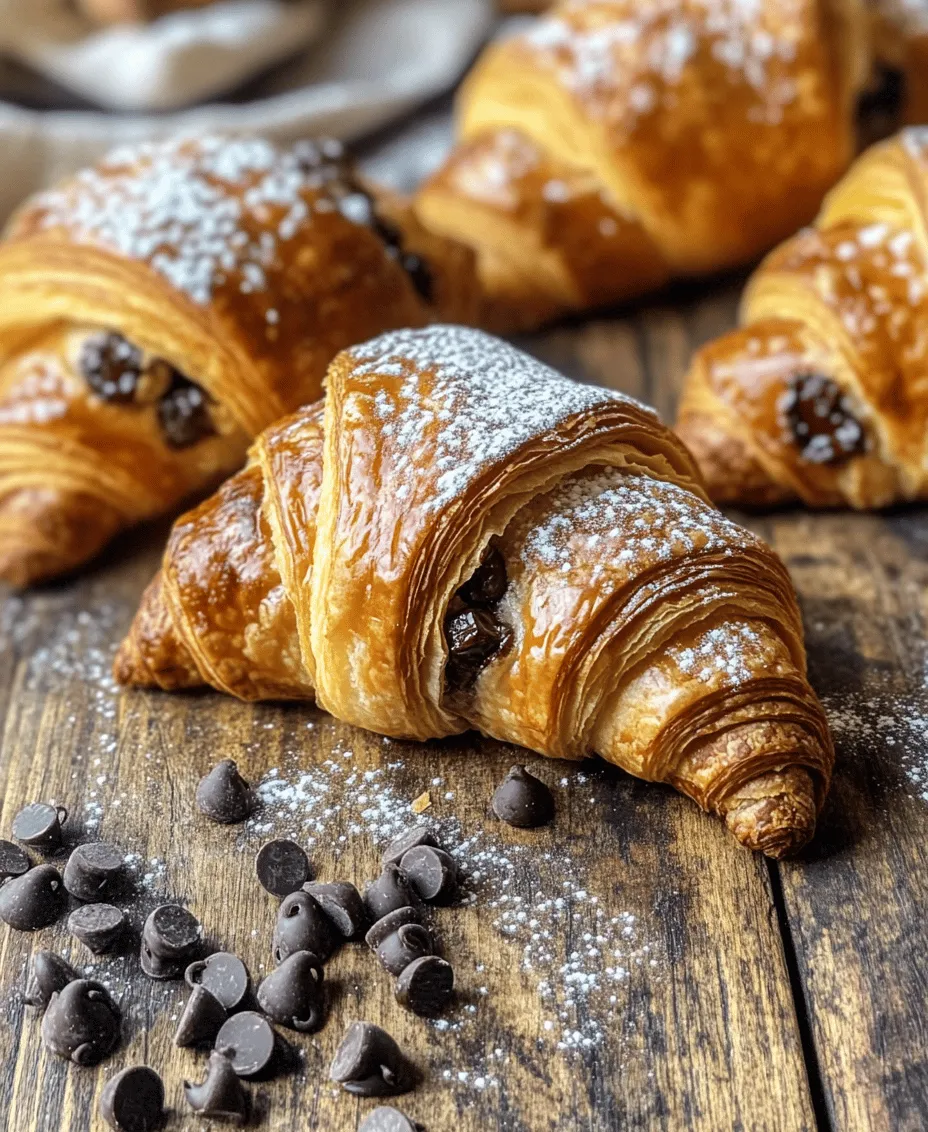Introduction
Chocolate croissants are not just pastries; they are a celebration of culinary artistry and indulgence. These flakey, buttery delights, also known as “pains au chocolat” in French, have won the hearts of many around the world. The combination of rich chocolate enveloped in layers of golden, crispy dough creates a visual and sensory experience that is hard to resist. Whether enjoyed as a morning treat with coffee, served at a brunch gathering, or savored as a decadent dessert, chocolate croissants elevate any occasion.
While you can easily find chocolate croissants at bakeries, there’s something incredibly satisfying and personal about making them at home. The process allows for creativity and customization, ensuring that every bite is infused with your unique touch. This recipe promises not only ease but also rewarding results that will impress your family and friends. With a little patience and the right techniques, you can master the art of creating heavenly chocolate croissants that are sure to become a staple in your kitchen.
Understanding the Basics of Croissant Dough
To appreciate the craftsmanship behind chocolate croissants, it is essential to understand what makes croissant dough unique. The foundation of this beloved pastry lies in its dough, which features a distinctive lamination process. Lamination involves folding layers of butter into the dough multiple times to create thin, flaky layers. When baked, these layers puff up beautifully, resulting in that iconic airy texture that croissants are famous for.
The secret to achieving this delightful flakiness lies in the balance of ingredients used in the dough. Each component plays a significant role in the final product:
– Whole Milk: Not only does whole milk contribute moisture to the dough, but it also helps activate the yeast, ensuring a proper rise.
– Active Dry Yeast: This ingredient is crucial for leavening the dough, allowing it to expand and create those light, airy layers.
– Granulated Sugar: Sugar enhances the flavor of the croissants and aids in activating the yeast by providing a food source.
– All-Purpose Flour: The backbone of the dough, all-purpose flour provides structure and strength.
– Salt: Salt is essential for balancing flavors and strengthening gluten, which contributes to the dough’s elasticity.
– Unsalted Butter: The star of the lamination process, butter creates rich layers and contributes to the flaky texture.
– Egg Wash: A mixture brushed onto the croissants before baking, the egg wash provides a beautiful golden color and a glossy finish.
– Chocolate Chips: The highlight of the recipe, chocolate chips are the decadent filling that makes these croissants irresistible.
– Optional Powdered Sugar: For those looking to add a final touch of sweetness, a dusting of powdered sugar can elevate the presentation.
Understanding these ingredients and their roles will not only enhance your baking experience but also empower you to make adjustments based on your preferences.
Ingredients Breakdown
Let’s dive deeper into the ingredients that will transform simple dough into a heavenly chocolate croissant:
1. Whole Milk: Whole milk is an essential ingredient that provides moisture to the dough. Its fat content also contributes to the richness of the croissants. When activated with warm water, the milk helps in creating a tender dough that rises beautifully during the baking process.
2. Active Dry Yeast: This is a leavening agent that plays a pivotal role in the dough’s rise. When mixed with warm milk and sugar, the yeast activates and produces carbon dioxide, which causes the dough to expand. Ensuring that the yeast is fresh and properly activated is crucial for achieving that light, airy texture in your croissants.
3. Granulated Sugar: Sugar not only sweetens the dough but also helps activate the yeast by providing a food source. It enhances the flavor profile of the croissants, making them more indulgent. A small amount of sugar is all that’s needed to elevate the overall taste without making the dough overly sweet.
4. All-Purpose Flour: The foundation of any dough, all-purpose flour provides the necessary structure and strength. It contains a moderate amount of protein, which helps develop gluten. This gluten formation is essential for the dough’s elasticity and contributes to the flaky texture of the croissants.
5. Salt: Salt is a flavor enhancer that balances the sweetness of the sugar and enriches the overall taste of the croissants. Furthermore, it strengthens the gluten structure, ensuring that the dough holds its shape during the lamination and baking processes.
6. Unsalted Butter: Unsalted butter is the star of the show when it comes to creating the flaky layers typical of croissants. The butter is folded into the dough multiple times during the lamination process. Its fat content is crucial for achieving the desired texture – light, flaky, and rich. The use of unsalted butter allows you to control the saltiness of the recipe.
7. Egg Wash: A mixture of beaten egg brushed onto the croissants before baking gives them a beautiful golden color and adds a glossy finish. This simple step enhances the visual appeal of your pastries, making them look as good as they taste.
8. Chocolate Chips: The filling of your chocolate croissants, chocolate chips provide that rich, melty chocolate experience that pairs perfectly with the buttery dough. You can choose semi-sweet, dark, or even milk chocolate chips depending on your taste preferences.
9. Optional Powdered Sugar: For those looking to add a touch of elegance, a dusting of powdered sugar can be added before serving. This optional ingredient not only enhances the visual presentation but also adds a hint of sweetness that complements the rich chocolate filling.
Step-by-Step Guide to Making Heavenly Chocolate Croissants
Now that you have a solid understanding of the ingredients, let’s move on to the first steps in creating your heavenly chocolate croissants. This process may seem intricate, but with patience and practice, you’ll find it deeply rewarding.
Activating the Yeast
The first step in making your croissant dough is activating the yeast. This is a crucial step that ensures your dough will rise properly.
1. Warm the Milk: Begin by gently warming 1 cup of whole milk in a saucepan or microwave until it’s warm to the touch but not boiling (about 100°F to 110°F). This temperature range is ideal for activating yeast, as it encourages it to thrive.
2. Combine Ingredients: In a small bowl, combine the warm milk with 2 tablespoons of granulated sugar and 2 teaspoons of active dry yeast. Stir gently to combine.
3. Let it Sit: Allow the mixture to sit for about 5 to 10 minutes. During this time, you should see bubbles forming on the surface, indicating that the yeast is active and producing carbon dioxide.
4. Visual Cues: Look for a foamy layer on top of the mixture. If you don’t see this bubbling action, it may indicate that the yeast is no longer viable, and you’ll need to start over with fresh yeast.
Making the Dough
Once your yeast is activated, it’s time to make the dough. Follow these steps for a smooth, well-mixed dough:
1. Mix the Dry Ingredients: In a large mixing bowl, combine 4 cups of all-purpose flour and 1 teaspoon of salt. Mix these dry ingredients together until they are evenly distributed.
2. Combine Wet and Dry Ingredients: Create a well in the center of the flour mixture and pour in the activated yeast mixture. Use a wooden spoon or spatula to mix the flour into the liquid, gradually bringing it together to form a shaggy dough.
3. Knead the Dough: Transfer the dough onto a lightly floured surface and begin kneading it. Knead for about 5-7 minutes until the dough becomes smooth and elastic. If it feels sticky, you can sprinkle a little more flour as needed.
4. Initial Rise: Once kneaded, shape the dough into a ball and place it in a lightly greased bowl. Cover it with a clean kitchen towel or plastic wrap and let it rise in a warm, draft-free environment for about 1 to 1.5 hours, or until it has doubled in size.
By following these initial steps carefully, you will set a strong foundation for creating perfectly flaky and delicious chocolate croissants. The next phases will involve the lamination process, where you will fold in the butter to create those famous layers. Stay tuned for the following sections, where you will learn how to bring your chocolate croissants to life!

Importance of the Well in the Flour Mixture
Creating the perfect dough for heavenly chocolate croissants begins with the flour mixture. One critical technique is forming a well in the center of the flour when adding wet ingredients. This method is essential as it allows the liquid to be gradually incorporated into the flour without creating lumps. A well helps in controlling the hydration of the flour, ensuring that the mixture comes together smoothly and evenly. When the liquid ingredients are poured into the well, they are absorbed by the flour gradually, leading to a more uniform dough and minimizing the risk of over-mixing.
Kneading the Dough
Techniques for Effective Kneading
Once the dough has come together, kneading is the next vital step. Kneading develops gluten, the protein that gives bread its structure and chewiness. To knead effectively, follow these steps:
1. Turn the Dough Out: Place the dough on a lightly floured surface to prevent sticking.
2. Fold and Push: Use the heel of your hand to push the dough away from you, then fold it back over itself. Rotate the dough a quarter turn and repeat this process.
3. Knead for Time: Knead the dough for about 8-10 minutes until it becomes smooth and elastic. If it sticks to your hands, lightly dust it with additional flour.
Signs That the Dough is Properly Kneaded
Knowing when your dough is adequately kneaded is crucial. Properly kneaded dough should be smooth and elastic, springing back when gently pressed. Additionally, you can conduct the “windowpane test.” Take a small piece of dough and stretch it gently; if it forms a thin, translucent membrane without tearing, you’ve achieved the right gluten development.
Preparing the Butter Layers
The Technique of Pounding and Rolling Cold Butter
For croissants, the butter layers are what create the signature flaky texture. Start with cold, unsalted butter, about 1 cup (226 grams). The butter should be at a firm, yet pliable consistency, which can be achieved by pounding it between two sheets of parchment paper using a rolling pin. Aim for a square shape about 1/2 inch thick. This technique ensures that the butter will be incorporated evenly during lamination.
Importance of Keeping Butter Chilled During Lamination
During the lamination process, it’s crucial to keep the butter chilled. If the butter melts into the dough, it will not create the desired layers. To maintain the right temperature, work in a cool environment and place the butter back in the refrigerator if it becomes too soft. Cold butter will create steam when baking, which is what ultimately results in those flaky layers.
Lamination Process
Explanation of Each Fold and Its Purpose
Lamination is the technique used to encase the butter within the dough, creating layers. Start by rolling out your dough into a rectangle that is about three times the length and twice the width of the butter square. Place the butter in the center of the dough and fold the dough over the butter like an envelope. This is known as the first “turn.” After sealing the edges, roll out the dough again and fold it into thirds, similar to a business letter. This process is repeated for a total of three folds, allowing for a total of 27 layers of dough and butter.
Tips for Maintaining Dough Temperature During This Process
As you laminate, be conscious of the dough’s temperature. If it begins to feel warm, place it in the refrigerator for 20-30 minutes to chill before continuing. This not only keeps the butter solid but also prevents the dough from becoming too elastic and difficult to roll.
Shaping the Croissants
Techniques for Cutting and Rolling the Dough
Once you’ve completed the necessary folds, it’s time to shape the croissants. Roll out the dough into a large rectangle, about 1/4 inch thick. Cut the dough into triangles with a base of about 4 inches. Starting at the wide end of each triangle, roll the dough tightly toward the point to form the croissant shape. Be gentle to maintain the layers of butter within the dough.
Tips for Ensuring a Tight Roll for Better Layering
For a perfect roll, ensure the dough isn’t too thin at the tip; otherwise, it could break apart. Additionally, avoid stretching the dough as you roll; instead, gently guide it to maintain the air pockets essential for flakiness. Pinch the edges to seal the croissant and place it on a baking tray lined with parchment paper.
Proofing the Croissants
Importance of Proofing for Texture and Rise
Proofing is a crucial step in the croissant-making process, allowing the dough to rise and develop flavor. The yeast activates during this time, leading to a lighter texture. Proper proofing can significantly impact the final product, giving your croissants that airy lift.
Ideal Conditions for Proofing Dough
To proof your croissants, find a warm, draft-free area. A temperature of around 75-80°F (24-27°C) is ideal. Cover the croissants with a clean kitchen towel or plastic wrap to prevent them from drying out. Allow them to rise until they have doubled in size, which typically takes about 1 to 2 hours.
Baking the Croissants
Preheating the Oven: Essential for a Perfect Bake
Preheating your oven is crucial for achieving that perfect golden brown finish on your croissants. Set your oven to 400°F (200°C) while the croissants are proofing. This ensures that the heat is evenly distributed and ready to create that flaky crust as soon as the dough enters.
Techniques for Achieving a Golden, Flaky Finish with Egg Wash
Before placing the croissants in the oven, brush them with an egg wash made by whisking together one egg with a tablespoon of water or milk. This step is essential for achieving a beautiful golden color. Be sure to apply it gently to avoid deflating the croissants.
Serving Suggestions and Pairings
Heavenly chocolate croissants are perfect for a delightful breakfast or brunch. Serve them warm, straight from the oven, and consider accompanying them with a dusting of powdered sugar for an elegant touch.
For beverage pairings, consider a rich espresso or a creamy cappuccino to complement the chocolate’s richness. A fresh orange juice can also provide a refreshing contrast.
Presentation is key; arrange the croissants on a beautiful platter, perhaps garnished with fresh fruit or a sprig of mint. This not only elevates the experience but also makes for an inviting centerpiece for your brunch table.
Conclusion
Creating heavenly chocolate croissants from scratch is a rewarding process that involves careful attention to detail and technique. From kneading the dough to achieving the perfect bake, each step contributes to the final result: flaky, buttery layers filled with rich chocolate.
The satisfaction derived from crafting these pastries in your own kitchen is unparalleled. You not only get to enjoy the delicious outcome but also the joy of sharing them with family and friends. So, gather your ingredients, embrace the process, and indulge in the pleasure of homemade baking. Whether it’s for a special occasion or simply to enjoy a weekend treat, these croissants are sure to impress.



